Experimental Soil Investigations
The possible impacts on soils are very diverse, so that standardized laboratory tests are not sufficient to describe the soil behaviour under special boundary conditions (e.g. thermal and hydraulic impacts). In the soil mechanical laboratory of the Institute of Geotechnical Engineering, the soil behaviour is investigated experimentally.
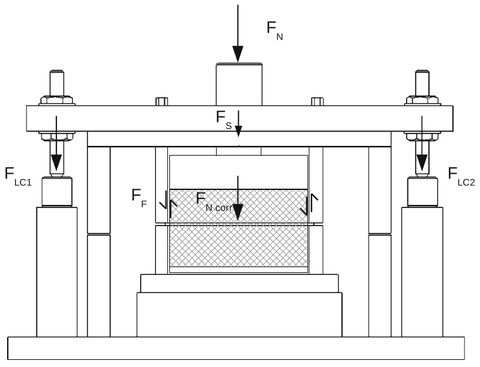
Schematic diagram of the direct shear device with integrated measurment of wall friction
For this purpose, new experimental setups were and are designed, calibrated and applied.
Experiments for determining the shear strength of soils are predominantly rate-controlled, for which an external load/stress is kept constant. However, this does not correspond to the soil loading in-situ. Often, the subsoil is unloaded while the shear stress increases (e.g. cut slopes) or it is subjected to a constant load (e.g. erection of an earth dam or a structure). Therefore, it is important to study the soil behaviour for controlled stress paths which correspond to the stress changes in the field.
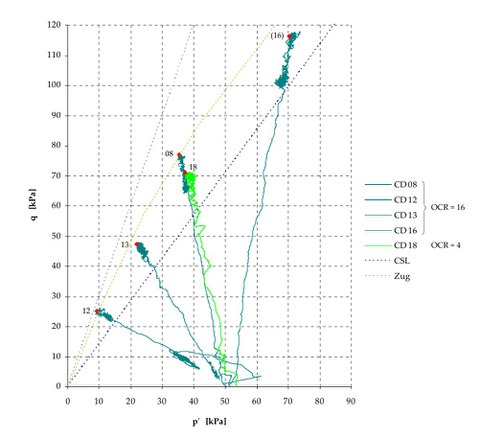
Effective stress paths of stress-controlled triaxial tests on overconsolidated soil
Furthermore, the state boundary condition of overconsolidated soils is non-linear. This is expressed by a more or less curved state boundary surface for small stresses.
Analysing the shear strength in standardized stress ranges may result in a missing detection of this curved state boundary surface. Thus, an assumption of an apparent shear strength in the stress-free state (cohesion) is the consequence. This approach leads to an overestimation of the shear strength at low stresses.
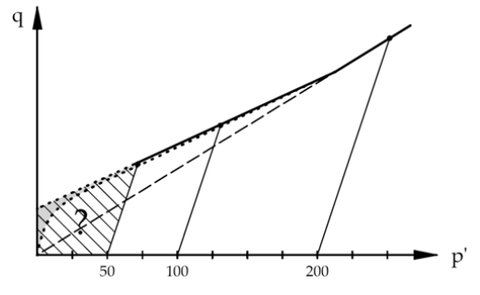
Depiction of a possible curved state boundary surface at small stresses for an overconsolidated soil
Stress paths with varying path inclinations can be examined in the triaxial testing device. Here, the lateral pressure is regulated by a computer-controlled adaptation of the cell pressure while the axial loading rate remains constant.
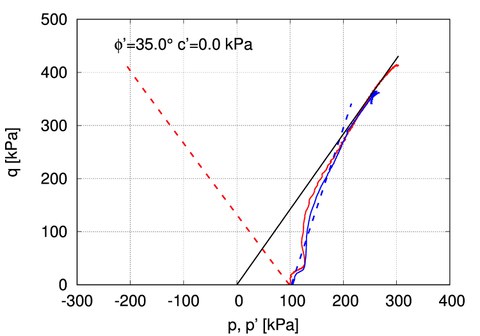
Undrained stress-controlled triaxial tests: total stress path (red dashed) in comparison to conventional CU triaxial test (blue) for the analysis of the development of pore water pressure and effective stresses during an undrained cut
The knowledge of soil behaviour during cyclic loading is advantageous when building foundations are carried out in seismic regions but also for foundation measures, where frequent load changes occur, e.g. for railways, machine foundations or wind turbines.
The soil response during cyclic loading depends on the load history (loose or dense soil), the water content (dry, saturated with water) and the boundary conditions in the laboratory or in-situ (drained/undrained behaviour, stress/strain controlled testing). For very small strains, the soil behaviour at each load reversal is characterized by an initial volume reduction. This can lead to a soil compaction and thus, settlements beneath a structure occur. For water-saturated soils and rapid load changes (undrained soil behaviour) this phenomenon in turn results in an increase in pore water pressures.
At the Institute of Geotechnical Engineering, soil behaviour under cyclic loading is investigated by means of triaxial compression tests. For the determination of changes in stiffness in the range of small strains, experiments with Bender-Elements or Resonant-Column tests are used.
At the Institute of Geotechnical Engineering, a procedure for the evaluation of shear tests was developed. Therefore, a checklist was designed with which shear tests can be analysed. By means of this approach, sub-tests of a test series can be selected which should be used for the determination of shear parameters (friction angle, cohesion).
The grain shape and roughness of soil grains influence significantly the mechanical behaviour of granular soils such as sand or gravel. The grain shape plays the main role in the structural arrangement of the grain skeleton. However, the determination of the particle size does not belong to the standard experiments in the soil mechanical laboratory, since there are no standardized and cost-effective investigation methods. Here, a parameter definition has to be found which maps the grain properties and distinguishes between the soil types.
Different methods can be used to determine the grain shape. Usually, a 2D-image of a grain is analysed. The pictures of the grains can be derived e.g. from microscopic images.
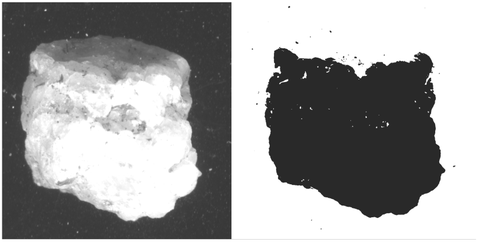
Scan of a sand grain and a subsequent edited image
A major drawback of this approach is the limited number of analysable soil grains. However, using a flatbed scanner several grains can be examined simultaneously. For the analysis of the images, software such as e.g. ImageJ can be used. The software determines automatically parameters such as the smallest and largest diameters and the sphericity. The sphericity provides information about how well a body approximates the shape of a sphere.
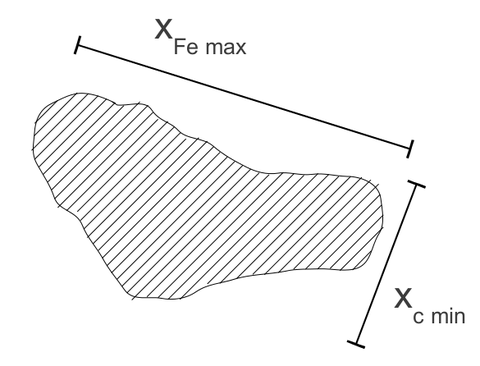
Principle of the determination of sphericity
At the Institute of Geotechnical Engineering model and element tests were carried out to determine the granulometric properties, such as grain shape and roughness. In particular, the resulting pore water pressure as a function of granulometry was investigated.
The loading of coarse-grained soils may result in a change of the granulometry, i.e. a change in grain shape and/or grain size. This also leads to a change in the mechanical properties of the soil.
A change in granulometry occurs e.g. during the installation of stone columns because the mechanical impact of the vibrator can break the gravel grains. At the Institute of Geotechnical Engineering, oedometric compression tests were carried out on gravel, before and after the installation in stone columns. A change in the compression behaviour was observed.
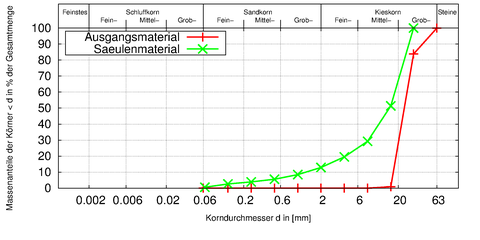
Grain size distribution for a gravel before and after the installation in stone columns
Flow forces caused by hydraulic pressure differences in the groundwater can lead to a failure of geotechnical structures in the ground. An example is the hydraulic failure at construction pit walls. Due to different water levels outside and within the excavation, a water flow occurs in the direction of the excavation pit. Correspond the flow force and the force due to the soil weight within the excavation pit, the latter one will disappear. As a consequence, the normal stresses will become zero and the soil loses its shear strength. Thus, the risk of lifting and failure of the soil layer due to hydraulic failure exists.
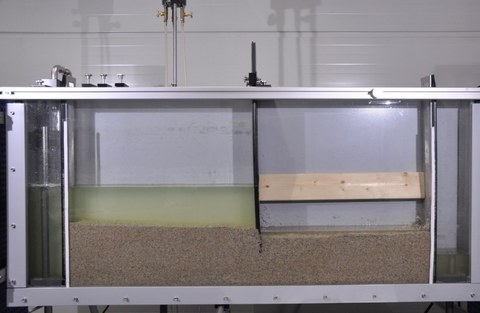
Water flow around a sheet pile wall before hydraulic failure
At the Institute of Geotechnical Engineering, it was examined whether hydraulic failure can be modelled in a model box and whether the standard stability proofs are also applicable here (Hagedorn 2018).
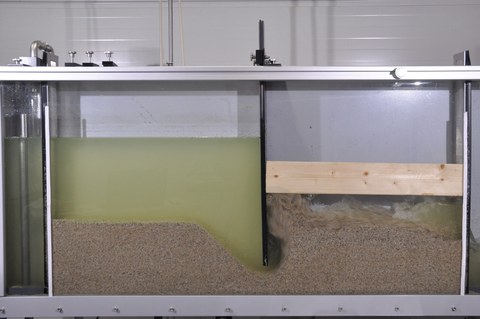
Water flow around a sheet pile wall during hydraulic failure
Since the verification for stability mainly depends on the size of the failure body on the side of the excavation pit, its extent is investigated by means of particle image velocimetry (PIV) at the Institute (Nöller 2019).
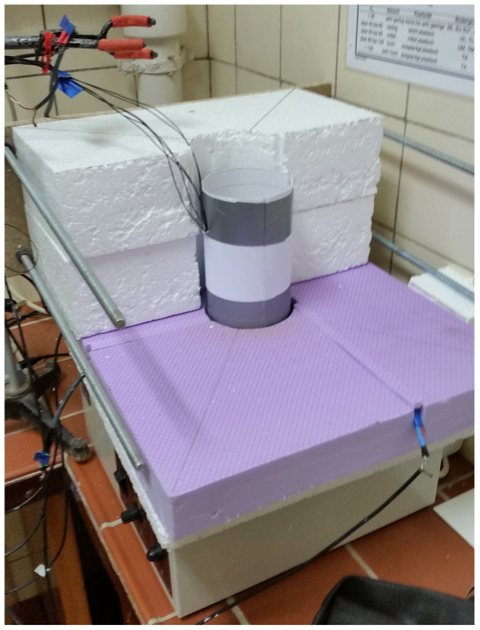
Testing device for analysing the thermal conductivity of soils
The thermal conductivity of soils is a soil characteristic which is gaining increasing interest. Precise knowledge of heat propagation in soils is needed more often to optimize current areas of application, e.g. geothermal plants or ground freezing.
To determine the thermal conductivity of materials, a variety oftesting procedures are known. However, not all of them are suitable for testing on soil samples. At the Institute of Geotechnical Engineering, a method for determining the thermal conductivity of soils was investigated. A testing device has been developed with which various influencing factors, e.g. density and degree of saturation, can be taken into account.

Numerical simulation of the thermal behaviour of a soil sample
